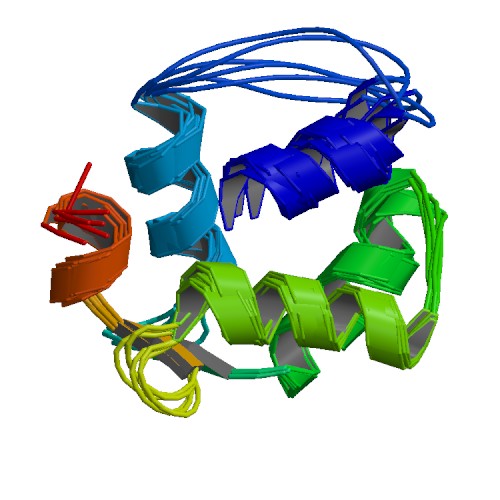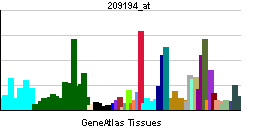CETN2
Jump to navigation
Jump to search
| Centrin, EF-hand protein, 2 | |||||||||||||
|---|---|---|---|---|---|---|---|---|---|---|---|---|---|
 PDB rendering based on 1m39. | |||||||||||||
| |||||||||||||
| Identifiers | |||||||||||||
| Symbols | CETN2 ; CALT; CEN2 | ||||||||||||
| External IDs | Template:OMIM5 Template:MGI HomoloGene: 55813 | ||||||||||||
| |||||||||||||
| RNA expression pattern | |||||||||||||
 | |||||||||||||
| More reference expression data | |||||||||||||
| Orthologs | |||||||||||||
| Template:GNF Ortholog box | |||||||||||||
| Species | Human | Mouse | |||||||||||
| Entrez | n/a | n/a | |||||||||||
| Ensembl | n/a | n/a | |||||||||||
| UniProt | n/a | n/a | |||||||||||
| RefSeq (mRNA) | n/a | n/a | |||||||||||
| RefSeq (protein) | n/a | n/a | |||||||||||
| Location (UCSC) | n/a | n/a | |||||||||||
| PubMed search | n/a | n/a | |||||||||||
Centrin, EF-hand protein, 2, also known as CETN2, is a human gene.[1]
Caltractin belongs to a family of calcium-binding proteins and is a structural component of the centrosome. The high level of conservation from algae to humans and its association with the centrosome suggested that caltractin plays a fundamental role in the structure and function of the microtubule-organizing center, possibly required for the proper duplication and segregation of the centrosome.[1]
References
Further reading
- Tanaka T, Okui K, Nakamura Y (1995). "Assignment of the human caltractin gene (CALT) to Xq28 by fluorescence in situ hybridization". Genomics. 24 (3): 609–10. PMID 7713520.
- Lee VD, Huang B (1994). "Molecular cloning and centrosomal localization of human caltractin". Proc. Natl. Acad. Sci. U.S.A. 90 (23): 11039–43. PMID 8248209.
- Chatterjee A, Tanaka T, Parrish JE, Herman GE (1996). "Refined mapping of caltractin in human Xq28 and in the homologous region of the mouse X chromosome places the gene within the bare patches (Bpa) and striated (Str) critical regions". Mamm. Genome. 6 (11): 802–4. PMID 8597638.
- Wolfrum U, Salisbury JL (1998). "Expression of centrin isoforms in the mammalian retina". Exp. Cell Res. 242 (1): 10–7. doi:10.1006/excr.1998.4038. PMID 9665797.
- Durussel I, Blouquit Y, Middendorp S; et al. (2000). "Cation- and peptide-binding properties of human centrin 2". FEBS Lett. 472 (2–3): 208–12. PMID 10788612.
- Mallon AM, Platzer M, Bate R; et al. (2000). "Comparative genome sequence analysis of the Bpa/Str region in mouse and Man". Genome Res. 10 (6): 758–75. PMID 10854409.
- Hartley JL, Temple GF, Brasch MA (2001). "DNA cloning using in vitro site-specific recombination". Genome Res. 10 (11): 1788–95. PMID 11076863.
- Simpson JC, Wellenreuther R, Poustka A; et al. (2001). "Systematic subcellular localization of novel proteins identified by large-scale cDNA sequencing". EMBO Rep. 1 (3): 287–92. doi:10.1093/embo-reports/kvd058. PMID 11256614.
- Araki M, Masutani C, Takemura M; et al. (2001). "Centrosome protein centrin 2/caltractin 1 is part of the xeroderma pigmentosum group C complex that initiates global genome nucleotide excision repair". J. Biol. Chem. 276 (22): 18665–72. doi:10.1074/jbc.M100855200. PMID 11279143.
- Salisbury JL, Suino KM, Busby R, Springett M (2003). "Centrin-2 is required for centriole duplication in mammalian cells". Curr. Biol. 12 (15): 1287–92. PMID 12176356.
- Strausberg RL, Feingold EA, Grouse LH; et al. (2003). "Generation and initial analysis of more than 15,000 full-length human and mouse cDNA sequences". Proc. Natl. Acad. Sci. U.S.A. 99 (26): 16899–903. doi:10.1073/pnas.242603899. PMID 12477932.
- Matei E, Miron S, Blouquit Y; et al. (2003). "C-terminal half of human centrin 2 behaves like a regulatory EF-hand domain". Biochemistry. 42 (6): 1439–50. doi:10.1021/bi0269714. PMID 12578356.
- Gavet O, Alvarez C, Gaspar P, Bornens M (2004). "Centrin4p, a novel mammalian centrin specifically expressed in ciliated cells". Mol. Biol. Cell. 14 (5): 1818–34. doi:10.1091/mbc.E02-11-0709. PMID 12802058.
- Popescu A, Miron S, Blouquit Y; et al. (2003). "Xeroderma pigmentosum group C protein possesses a high affinity binding site to human centrin 2 and calmodulin". J. Biol. Chem. 278 (41): 40252–61. doi:10.1074/jbc.M302546200. PMID 12890685.
- Kilmartin JV (2003). "Sfi1p has conserved centrin-binding sites and an essential function in budding yeast spindle pole body duplication". J. Cell Biol. 162 (7): 1211–21. doi:10.1083/jcb.200307064. PMID 14504268.
- Chang F, Re F, Sebastian S; et al. (2004). "HIV-1 Vpr induces defects in mitosis, cytokinesis, nuclear structure, and centrosomes". Mol. Biol. Cell. 15 (4): 1793–801. doi:10.1091/mbc.E03-09-0691. PMID 14767062.
- Tourbez M, Firanescu C, Yang A; et al. (2005). "Calcium-dependent self-assembly of human centrin 2". J. Biol. Chem. 279 (46): 47672–80. doi:10.1074/jbc.M404996200. PMID 15356003.
- Gerhard DS, Wagner L, Feingold EA; et al. (2004). "The status, quality, and expansion of the NIH full-length cDNA project: the Mammalian Gene Collection (MGC)". Genome Res. 14 (10B): 2121–7. doi:10.1101/gr.2596504. PMID 15489334.
- Wiemann S, Arlt D, Huber W; et al. (2004). "From ORFeome to biology: a functional genomics pipeline". Genome Res. 14 (10B): 2136–44. doi:10.1101/gr.2576704. PMID 15489336.
- Nishi R, Okuda Y, Watanabe E; et al. (2005). "Centrin 2 stimulates nucleotide excision repair by interacting with xeroderma pigmentosum group C protein". Mol. Cell. Biol. 25 (13): 5664–74. doi:10.1128/MCB.25.13.5664-5674.2005. PMID 15964821.
| This protein-related article is a stub. You can help Wikipedia by expanding it. |